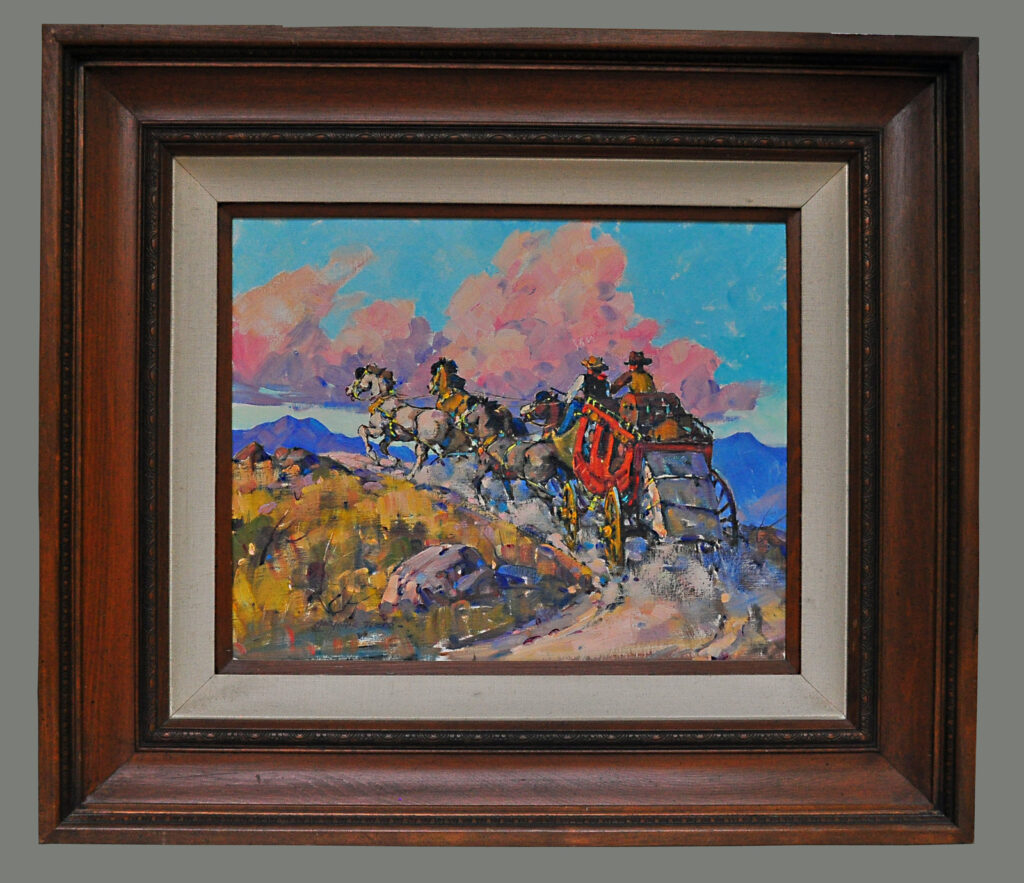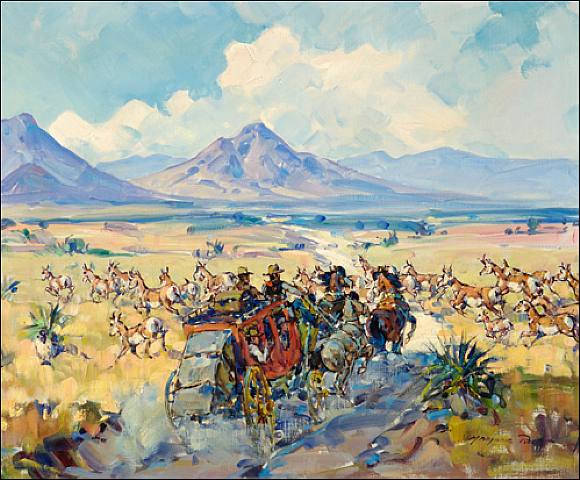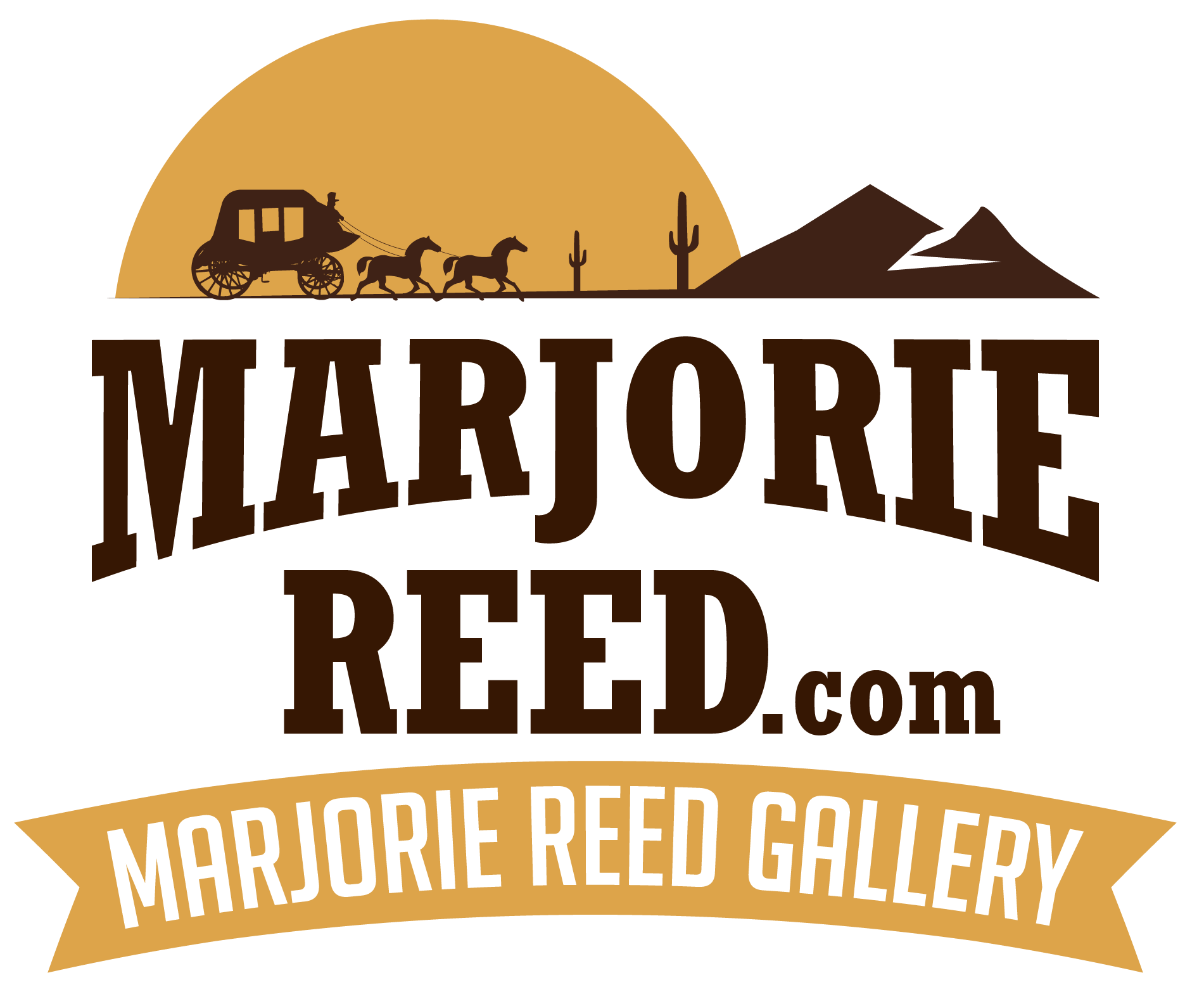Remember, boys, nothing on God’s earth must stop the US mail. This was Jon Butterfield’s maximum to his drivers, conductors and stage personnel. In 1857 an act of Congress authorized the adoption of a mail and passenger stage line, awarding the contract to John Butterfield, an experienced stage driver and express man from New York State. Since the god rush of 49 the west had been badly in need of overland transportation that would prove faster and more effective than the long, circuitous routes around the Horn and across the Isthmus of Panama.
This new route with the eastern terminus a Tipton, Missouri and te western at San Francisco, was called the Ox Bow Route as it followed a great arc, swinging south from Tipton and veering southwestward through Ft. Smith, Arkansas and into the southeast corner of Oklahoma, ferrying the Red River and into Texas’ thence it traversed the Staked Plains or Llano Estacado as they were called, to El Paso. The Rio Grande was forded at Mesilla, entering New Mexico Territory which included Arizona at that time. From Yuma the trail swung north through California, completing the arc at San Francisco. The contract provided for one year of preparation, calling for the first service from Tipton to San Francisco to begin September 16, 1858, with semi-weekly runs over the 2800 miles to be covered in a maximum of 25 days. A branch line from Memphis connected with the main line at Fort Smith. Two main divisions with El Paso midway, were divided into nine minor divisions. Each division had a superintendent responsible for stations, stock, roads and all supplies needed for his division.
A year later there were about two hundred. In the second year of operation a section of the route was changed from the remote Guadalupe Mountain area to the “fort trail” to the south, following the Rio Grande from El Paso to Forts Quitman, Davis, and Stockton, crossing the Pecos River at Horsehead Crossing instead of the original Emigrant Crossing near Pope’s Camp. Stations averaged about twenty miles apart. Some were meal stations. All were “change” stations (change of horses) and about every three hundred miles an fresh coach was supplied. Two meals were served each day, and passengers were advised o take along extra food as well as blankets.
Concord coaches and celerity wagons were the main vehicles used on the route and were kept rolling night and day. The matter of sleep proved to be quite a problem for the first day or two, but soon the passengers found themselves dozing off from sheer exhaustion. A conductor was responsible for the mail on his coach as well as the passengers. It was his duty to sound a call on a small brass bugle upon approaching each station o alert the station keepers to have teams ready for the change which usually took about five minutes. The Butterfield Overland Stage Line was the longest stage coach route in the world. At the beginning of the route, fares for eastbound passengers were $100 and for those going west $200. Eventually they were reduced to $150 each way.
The Civil War and the consequent removal of the troops stationed at forts along the stage road as well as the confiscation of Overland property and stations by the Secessionists, brought the great Overland Mail to an abrupt halt in March of 1861, Stock, coaches and equipment were transferred.
The Butterfield Overland Stage in Oklahoma, Arkansas and Missouri
The contract, provided for one year of preparation, calling for the first service from Tipton to San Francisco to begin September 16, 1858, with semi-weekly runs over the 2800 miles to be covered in a maximum of 25 days. A branch line from Memphis connected with the main line at Fort Smith. Two main divisions with El Paso midway, were divided into nine minor divisions. Each division had a superintendent responsible for stations, stock, roads and all supplies needed for his division. When the line started operation in September of 1858, one hundred forty one stations were listed. A year later there were about two hundred. In the second year of operation a section of the route was changed from the remote Guadalupe Mountain areas of the fort trail to the south, following the Rio Granded from Elk Paso to Forts Quitman, Davis, and Stockton, crossing the Pecos River at Horsehead Crossing instead of the original Emigrant Crossing near Pope’s Camp.
Stations averaged about twenty miles apart. Some were meal stations. All were change stations (change of horses) and about every three hundred miles a fresh coach was supplied. Two meals were served each day, and passengers were advised to take along extra food as well as as blankets. Concord coaches and celerity wagons were the main vehicles used on the route and were kept rolling night and day. The matter of sleep proved to be quite a problem for the first day or two, but soon the passengers found them dozing off from sheer exhaustion. A conductor was responsible for the mail on his coach as well as the passengers. It was his duty to sound a call on a small brass bugle upon approaching each station to alert the station keepers to have teams ready for the change which usually took about five minutes.
The Butter field Overland Stage Line was the longest stage coach route in the world. At the beginning of the route, fares for eastbound passengers were $100 and for those going west $200. Eventually they were reduced to $150 each way. The Civil War and the consequent removal of the troops stationed at forts along the stage road as well as the confiscation of Overland property and stations by the Secessionists, brought the great Overland Mail to an abrupt halt in March of 1967. Stock, coaches and equipment were transferred to the Central Route. Thus ended one of the workd’s most spectacular, colorful and beneficial institions on record.
John Butterfield was born in Berne, New York, about thirty miles Southwest of Albany of November 18, 1801, son of Daniel and Catherine Ebert Butterfiled, but very little is known of his early years. Mrs. John Staplton of the Berne Historical Society comments that it is unfortunate that he did not keep a diary or member of the family to write about him, Julia Lorrilard Butterfield, a daughter-in-law, in her book. His connections with the transportation business pointed out corduroy roads through the area, with experience helped him greatly when he came to establish the Overland Mail. He was also one of the first to realize the importance of North-South roads as well as the migratory East-West roads of the time and he established a stage line from Utica South, connecting with other lines at Mt. Pleasant, to New York vis Newburgh, and Philadelphia vis Easton, PA. His success with the Overland Mail is well documented and can readily be appreciated by reading of the previous attempts to important result of this line was that it connected the East and West and possibly kept California and the Southwestern territories a part of the United States. California had been a state for eight years at the time.
We buy 100’s of Marjorie Reed (Harvey Day) paintings for not only our personal collection but also to sell to private collectors. If you have a painting or collection for sell give us a call for a free evaluation and bid on purchasing the paintings. We rarely get outbid when it comes to buying original oil paintings by Marjorie Reed.







